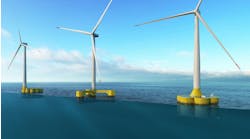Editor's note: This Renewable Energy column first appeared in the July-August issue of Offshore magazine. Click here to view the full issue.
By Bruce Beaubouef, Managing Editor
Floating solar systems are increasingly in demand as societies look for ways to meet growing power needs with renewable energy technologies. Floating solar and photovoltaic (PV) technologies are said to have huge potential in areas where difficult terrain and land scarcity may pose challenges to the development of ground-mounted solar systems; and where there is significant need for local renewable energy production.
One notable recent example can be seen offshore China, where CIMC Raffles says that it has developed the country’s first semisubmersible offshore photovoltaic power generation platform. The semisubmersible was recently launched, towed and delivered to CIMC Jiguang Marine Technology (Yantai) Co. Ltd. (CIMC Collector).
According to CIMC, the platform is “a self-developed and self-owned intellectual property,” and it has been towed to the designated location for deployment. The solar power platform has four single float arrays and a total installed capacity of 400 kWp as well as a net deck area of about 1,900 sq meters.
The platform is equipped with eight systems: floating structure support, buoyancy material, multi-body connection and mooring, fender collision avoidance, PV power generation and inverter, intelligent monitoring, dynamic subsea cable transmission, and power consumption.
CIMC said the platform can operate safely in open sea areas with wave heights of up to 6.5 m, wind speeds of up to 34 m per second and tidal differences of up to 4.6 m.
Meanwhile, SolarinBlue has deployed what it claims are the first offshore floating solar modules in the Mediterranean Sea and the first offshore France. The first two floating photovoltaic units are for the Sun’Sète project, a demonstration project in a harbor along coastal southern France, on the site of a former offshore oil unloading station. Twenty-three more modules are expected to be added over the next few months over a 0.5-ha area, increasing the total installed power to 300 kWp.
At that point, production capacity should be 400 MWh/year with the electricity generated transported by a submarine cable to supply infrastructures around the harbor at Sète.
SolarinBlue started development in 2021 and obtained all administrative authorizations in 2022. The French authorities are said to have scrutinized the environmental aspects of the project.
WATCH THE ACCOMPANYING VIDEO:
Video: Floating solar technologies being deployed at an increasing pace | Offshore (offshore-mag.com)
The company, founded in 2019, is now developing a portfolio of offshore solar projects in France and internationally.
Floating PV technologies are being advanced on other fronts as well. Recently, Belgian partners DEME, Tractebel and Jan De Nul released SEAVOLT, another new offshore floating PV technology. This technology is a result of joint R&D efforts which combine the work of solar, environmental, and offshore experts.
SEAVOLT is said to be able to withstand harsh offshore conditions while creating large surfaces that are protected from the waves. The benefits of the technology are said to include local renewable energy production and the possibility to install the panels in offshore wind farms, where local authorities permit multi-use concessions. Another advantage is the addition of large volumes of renewable energy capacity in a relatively short time.
The partners, together with Ghent University, started the VLAIO-funded research project MPVAQUA (Marine PV Aquaculture) within the frame of Blue Cluster four years ago. A marine floater concept was developed together with initial research on effects on the marine ecosystem, integration of aquaculture and a financial assessment.
Following laboratory testing, the partners are currently developing an offshore test installation, which will be launched off the Belgian coast sometime this summer.
Elsewhere, in the Netherlands, efforts are being made to design offshore solar technologies that can withstand high wave action. Earlier this year, Bureau Veritas issued an approval-in-principle (AiP) to Oceans of Energy for its design of a high-wave offshore solar farm system.
This “lightweight offshore solar farm system” has been operating in the North Sea since 2019, with a capacity of 0.5 MW. It uses the sea surface directly as support, and designers say that it is similar to “a waterlily resting on the water surface.” To withstand high waves and rough seas, a combination of rigid and flexible structures allows the system to “ride” on the waves.
Since its deployment, the system has withstood multiple severe storms, with waves up to 9.9 m high. It has also been successfully basin-tested with 13-m high waves.
The AiP follows two years’ engagement between Oceans of Energy and Bureau Veritas. It covers all aspects and equipment required for the production of an offshore solar farm system, including Oceans of Energy’s design base, the floaters, mounting of the solar panels, scale model testing reports, and mooring system design. Rough North Sea conditions were used in the reviewed tests on the system, with load cases applied to determine all necessary structural calculations.
In addition to stand-alone floating solar systems, analysts believe that the growing use of offshore wind energy offers additional opportunities. In such cases, floating solar technology could serve as an important complementary power system to wind energy. As authorities increasingly allow for multi-use concessions, and as the grid infrastructure shows potential for combined use, the addition of offshore floating solar to current and future offshore wind sites is expected to present an opportunity to add large volumes of additional renewable energy.
Back in March, Tractebel CEO Philippe Van Troeye said: “In the same way that we have seen wind technology moving from land to the sea, we are seeing the extension of the whole energy system toward offshore locations. Along with offshore green fuel production, offshore energy islands, interconnectors and potential solutions for energy storage, we believe offshore floating PV has an important role to play in the acceleration of the energy transition.”




